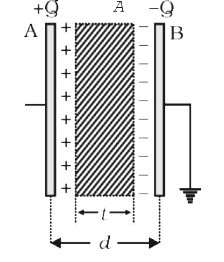Find an expression for the capacitance of a parallel plate capacitor when a dielectric slab of dielectric constant K and thickness t=d2 but the same area on the plates is inserted between the the capacitors plate. (d=separation between the plates)
Consider a parallel plate capacitor, area of each plate being A, the separation between the plates being d. Let a dielectric slab of dielectric constant K and thickness t<d be placed between the plates. The thickness of air between the plates is (d – t). If charges on plates are +Q and – Q, then surface charge density σ=QA. the electric
field between the plates in air E1=σε0=Qε0A
The electric field between the plates in slab E2=σKε0=QKε0A
∴The potential difference between the plates VAB=work done in carrying unit positive charge from one plate to another=∑Ex (as field between the plates is not constant)
=E1(d−t)+E2t=Qε0A(d−t)+QKε0At ∴VAB=Qε0A[d−t+tK]
∴Capacitance of capacitor C=QVAB=QQε−(0)A(d−t+tK)or,C=(ε0A)?(d−t+tK)=ε0Ad−t(1−1K)
Here, t=d2 ∴C=ε0Ad−d2(1−1K)=ε0Ad2(1+1K).

Similar Questions
Explain why the capacitance of a parallel plate capacitor increases when a dielectric slab is introduced between the plates.
View SolutionIn absence of dielectric medium capacity of a parallel plate capacitor is C0 .A sheet of dielectric constant K and thickness of one third of the plate separation is inserted between the plates.If new capacity is C ,then
View Solution
Knowledge Check
- Question 1 - Select One
A parallel plate capacitor carries a harge Q. If a dielectric slab with dielectric constant K=2 is dipped between the plates, then
Athe stored energy remains unchanged.Bthe stored energy is increased by a factor of 2.Cthe stored energy is reduced to half its previous value.Dnone of the above is correct. - Question 2 - Select One
A parallel -plate air capacitor has capacity C. A dielectric slab of dielectric constant K, whose thickness is half of the air gap between the plates, is now inserted between the plates. The capacity of the capacitor will now be
AKC/2B2KC/(K+1)C2KC/(K−1)DC(K+1)/(K−1) - Question 3 - Select One
Separation between the plates of a parallel plate capacitor is d and the area of each plates is A. When a slab of material of dielectric constant k and thickness t(t<d) is introduced between the plates. Its capacitance becomes
Aε0Ad+t(1−1k)Bε0Ad+t(1+1k)Cε0Ad−t(1−1k)Dε0Ad−t(1+1k)
Find the capacitance between A and B if three dielectric slabs of dielectric constants K1areaA _(2)andthick≠ssd_(2))are∈sertedbetweentheplatesofaparal≤llate∩aci→rofplateareaA.(Giventˆthedistancebetweenthetwoplatesisd_(1)=d_(2)+d_(2).)
 .View Solution
.View SolutionThe capacitance of a capacitor becomes 4/3 times its original value if a dielectric slab of thickness t=d/2 is inserted between the plates (d is the separation between the plates). What is the dielectric constant of the slab?
View SolutionIntroduction of a dielectric slab of dielectric constant K between the plates |When the battery is disconnected |When the battery remains connected |Questions |Force between capacitor plates
View SolutionThe potential energy of a charged parallel plate capacitor is U0. If a slab of dielectric constant K is inserted between the plates, then the new potential energy will be
View SolutionIf a dielectric slab of thickness 5 mm and dielectric constant K=6 is introduced between the plates of a parallel plate air capacitor, with plate separation of 8 mm, then its capacitance is
View Solution

